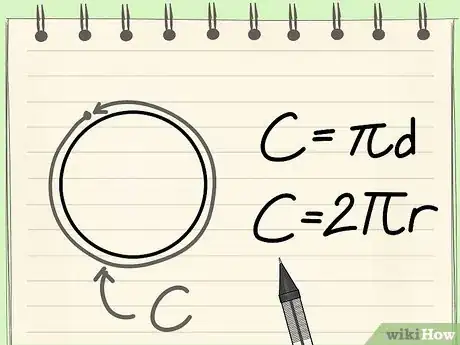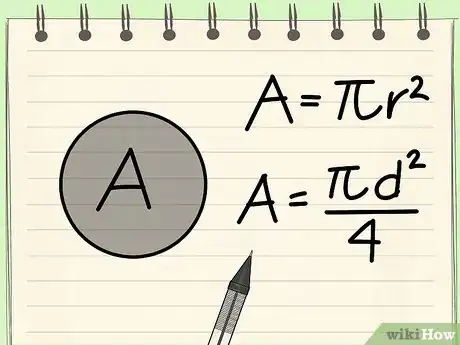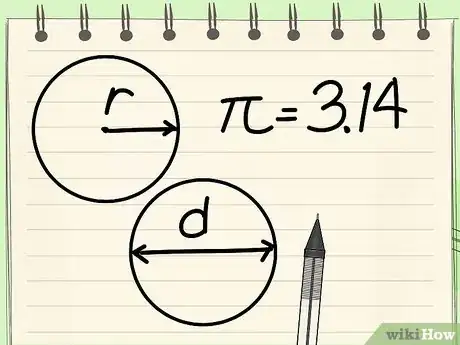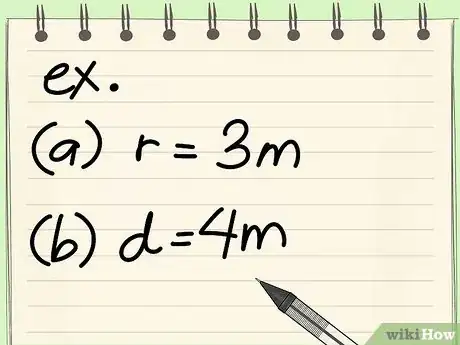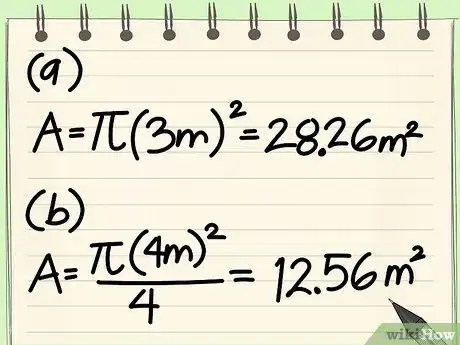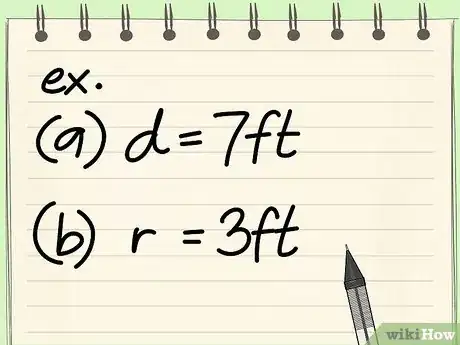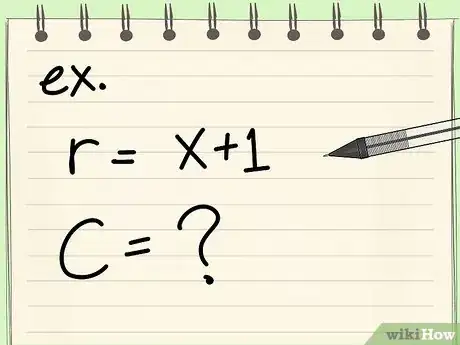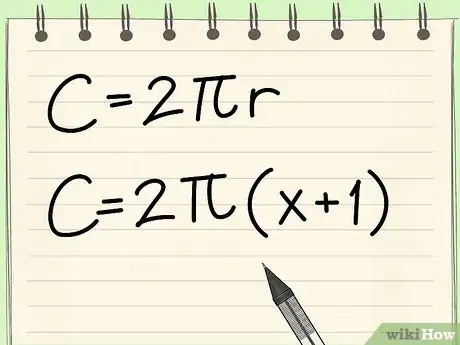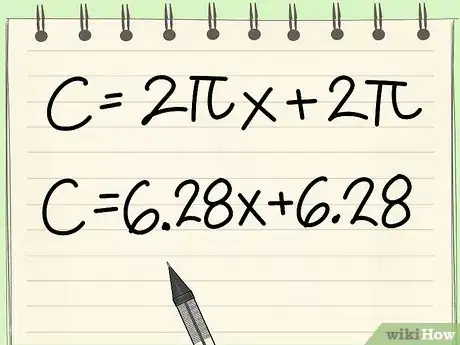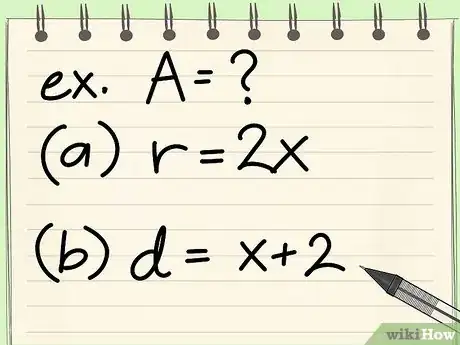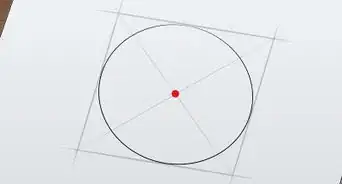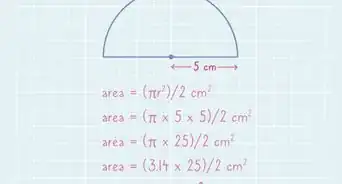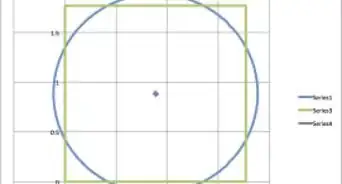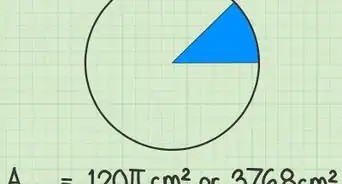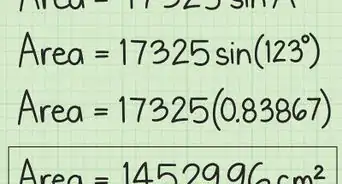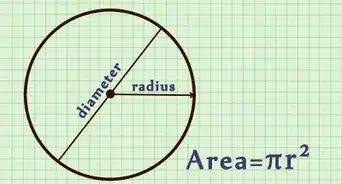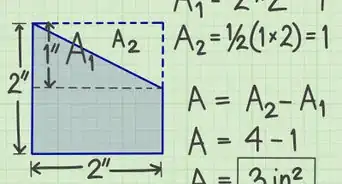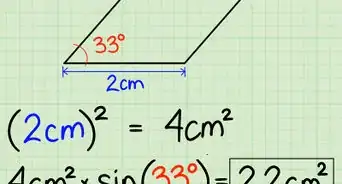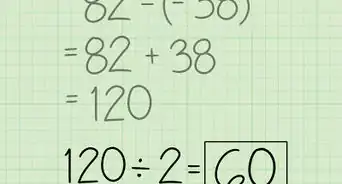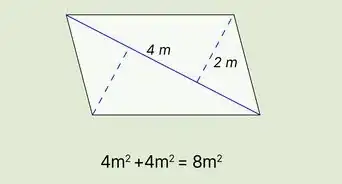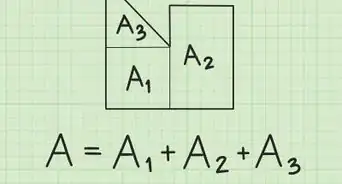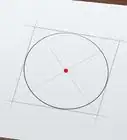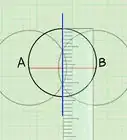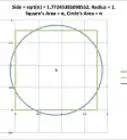This article was co-authored by Grace Imson, MA. Grace Imson is a math teacher with over 40 years of teaching experience. Grace is currently a math instructor at the City College of San Francisco and was previously in the Math Department at Saint Louis University. She has taught math at the elementary, middle, high school, and college levels. She has an MA in Education, specializing in Administration and Supervision from Saint Louis University.
There are 12 references cited in this article, which can be found at the bottom of the page.
This article has been viewed 204,524 times.
A circle is the set of all points in a plane that are a fixed distance, called the radius, from a fixed point, called the center. [1] The circumference (C) of a circle is its perimeter, or the distance around it.[2] The area (A) of a circle is how much space the circle takes up or the region enclosed by the circle.[3] Both area and perimeter can be calculated with simple formulas using the radius or diameter of the circle and the value of pi.
Steps
Calculating the Circumference
-
1Learn the formula for circumference. There are two formulas that can be used to calculate the circumference of a circle: C = 2πr or C = πd, where π is the mathematical constant approximately equal to 3.14,[4] r is equal to the radius, and d is equal to the diameter.[5]
- Because the radius of a circle is equal to twice its diameter, these equations are essentially the same.
- The units for circumference can be any unit for the measure of length: feet, miles, meters, centimeters, etc.
-
2Understand the different parts of the formula. There are three components to finding circumference of a circle: radius, diameter, and π. The radius and diameter are related: the radius is equal to half the diameter, while the diameter is equal to double the radius.[6]
- The radius (r) of a circle is the distance from one point on the circle to the center of the circle.
- The diameter (d) of a circle is the distance from one point on the circle to another directly opposite it, going through the circle's center.[7]
- The Greek letter pi (π) represents the ratio of the circumference divided by the diameter and is represented by the number 3.14159265…, an irrational number that has neither a final digit nor a recognizable pattern of repeating digits.[8] This number is commonly rounded to 3.14 for basic calculations.
Advertisement -
3Measure the radius or diameter of the circle. Using a ruler, place one end at one side of the circle and place it through the center point to the other side of the circle. The distance to the center of the circle is the radius, while the distance to the other end of the circle is the diameter.[9]
- In most textbook math problems, the radius or diameter is given to you.
-
4Plug in the variables and solve. Once you have determined the radius and/or diameter of the circle, you can plug these variables into the appropriate equation. If you have the radius, use C = 2πr, but if you have the diameter, use C = πd.[10]
- For example: What is the circumference of a circle with a radius of 3 cm?
- Write the formula: C = 2πr
- Plug in the variables: C = 2π3
- Multiply through: C = (2*3*π) = 6π = 18.84 cm
- For example: What is the circumference of a circle with a diameter of 9 m?
- Write the formula: C = πd
- Plug in the variables: C = 9π
- Multiply through: C = (9*π) = 28.26 m
- For example: What is the circumference of a circle with a radius of 3 cm?
-
5Practice with a few examples. Now that you've learned the formula, it's time to practice with a few examples. The more problems you solve, the easier it becomes to solve them in the future.
- Find the circumference of a circle with a diameter of 5 ft.
- C = πd = 5π = 15.7 ft
- Find the circumference of a circle with a radius of 10 ft.
- C = 2πr = C = 2π10 = 2 * 10 * π = 62.8 ft.
- Find the circumference of a circle with a diameter of 5 ft.
Calculating the Area
-
1Learn the formula for area of a circle. The area of a circle can be calculated using the diameter or the radius with two different formulas: A = πr2 or A = π(d/2)2,[11] where π is the mathematical constant approximately equal to 3.14,[12] r is equal to the radius, and d is the diameter.[13]
- Because the radius of a circle is equal to half its diameter, these equations are essentially the same.
- The units for area can be any unit for the measure of length squared: feet squared (ft2), meters squared (m2), centimeters squared (cm2), etc.
-
2Understand the different parts of the formula. There are three components to finding circumference of a circle: radius, diameter, and π. The radius and diameter are related: the radius is equal to half the diameter, while the diameter is equal to double the radius.[14]
- The radius (r) of a circle is the distance from one point on the circle to the center of the circle.
- The diameter (d) of a circle is the distance from one point on the circle to another directly opposite it, going through the circle's center.[15]
- The Greek letter pi (π) represents the ratio of the circumference divided by the diameter and is represented by the number 3.14159265…, an irrational number that has neither a final digit nor a recognizable pattern of repeating digits.[16] This number is commonly rounded to 3.14 for basic calculations.
-
3Measure the radius or diameter of the circle. Using a ruler, place one end at one side of the circle and place it through the center point to the other side of the circle. The distance to the center of the circle is the radius, while the distance to the other end of the circle is the diameter.
- In most textbook math problems, the radius or diameter is given to you.
-
4Plug in the variables and solve. Once you have determined the radius and/or diameter of the circle, you can plug these variables into the appropriate equation. If you have the radius, use A = πr2, but if you have the diameter, use A = π(d/2)2.[17]
- For example: What is the area of a circle with a radius of 3 m?
- Write the formula: A = πr2
- Plug in the variables: A = π32
- Square the radius: r2 = 32 = 9
- Multiply by pi: A = 9π = 28.26 m2
- For example: What is the area of a circle with a diameter of 4 m?
- Write the formula: A = π(d/2)2
- Plug in the variables: A = π(4/2)2
- Divide the diameter by 2: d/2 = 4/2 = 2
- Square the result: 22 = 4
- Multiply by pi: A = 4π = 12.56 m2
- For example: What is the area of a circle with a radius of 3 m?
-
5Practice with a few examples. Now that you've learned the formula, it's time to practice with a few examples. The more problems you solve, the easier it becomes to solve them in the future.
- Find the area of a circle with a diameter of 7 ft.
- A = π(d/2)2 = π(7/2)2 = π(3.5)2 = 12.25 * π= 38.47 ft2.
- Find the area of a circle with a radius of 3 ft.
- A = πr2 = π32 = 9 * π = 28.26 ft2
- Find the area of a circle with a diameter of 7 ft.
Calculating Area and Circumference with Variables
-
1Determine the radius or diameter of the circle. Some problems may give you a radius or diameter that has a variable in it: r = (x + 7) or d = (x + 3). In this case, you can still solve for the area or circumference, but your final answer will also have that variable in it. Write down the radius or diameter as it is stated in the problem.
- For example: Calculate the circumference of a circle with a radius of (x = 1).
-
2Write the formula with the information given. Whether you are solving for area or circumference, you will still follow the basic steps of plugging in what you know. Write down the formula for area or circumference and then write in the variables given.
- For example: Calculate the circumference of a circle with a radius of (x + 1).
- Write the formula: C = 2πr
- Plug in the given information: C = 2π(x+1)
-
3Solve as if the variable were a number. At this point, you can just solve the problem as you normally would, treating the variable as if it were just another number. You may need to use the distributive property to simplify the final answer.
- For example: Calculate the circumference of a circle with a radius of (x = 1).
- C = 2πr = 2π(x+1) = 2πx + 2π1 = 2πx +2π = 6.28x + 6.28
- If you are given the value of “x” later in the problem, you can plug it in and get a whole number answer.
-
4Practice with a few examples. Now that you've learned the formula, it's time to practice with a few examples. The more problems you solve, the easier it becomes to solve them in the future.
- Find the area of a circle with a radius of 2x.
- A = πr2 = π(2x)2 = π4x2 = 12.56x2
- Find the area of a circle with a diameter of (x + 2).
- A = π(d/2)2 = π((x +2)/2)2 = ((x +2)2/4)π
- Find the area of a circle with a radius of 2x.
Community Q&A
-
QuestionHow do we figure circumference if the area of a circle is 3.14 cm squared?
 DonaganTop AnswererDivide the area by pi; that gives you r ². Find the square root; that gives you r. Double it; that gives you the diameter. Multiply by pi; that gives you the circumference.
DonaganTop AnswererDivide the area by pi; that gives you r ². Find the square root; that gives you r. Double it; that gives you the diameter. Multiply by pi; that gives you the circumference. -
QuestionHow do I find the area of a circle when I have the circumference?
 Community AnswerPi x diameter = Pi x (2 x radius) = Circumference So: Radius = Circumference/(2xPi) Once you have the radius, use this formula: Area = Pi x radius^2
Community AnswerPi x diameter = Pi x (2 x radius) = Circumference So: Radius = Circumference/(2xPi) Once you have the radius, use this formula: Area = Pi x radius^2 -
QuestionHow do I find the circumference of a circle that has an area of 452.16 square meters?
 DonaganTop AnswererDivide the area by pi. That's the square of the radius. Find the square root. That's the radius. Double it. That's the diameter. Multiply by pi. That's the circumference.
DonaganTop AnswererDivide the area by pi. That's the square of the radius. Find the square root. That's the radius. Double it. That's the diameter. Multiply by pi. That's the circumference.
References
- ↑ http://www.mathopenref.com/circle.html
- ↑ http://www.mathopenref.com/circumference.html
- ↑ http://www.mathopenref.com/circlearea.html
- ↑ https://www.mathsisfun.com/numbers/pi.html
- ↑ https://www.omnicalculator.com/math/circumference
- ↑ https://www.omnicalculator.com/math/circumference
- ↑ http://www.mathopenref.com/diameter.html
- ↑ https://www.mathsisfun.com/definitions/pi.html
- ↑ https://www.khanacademy.org/math/cc-seventh-grade-math/cc-7th-geometry/cc-7th-area-circumference/a/radius-diameter-circumference
- ↑ https://www.mathsisfun.com/numbers/pi.html
- ↑ https://www.mathsisfun.com/geometry/circle-area.html
- ↑ http://www.mathopenref.com/pi.html
- ↑ Grace Imson, MA. Math Instructor, City College of San Francisco. Expert Interview. 1 November 2019.
- ↑ https://www.omnicalculator.com/math/area-of-a-circle
- ↑ http://www.mathopenref.com/diameter.html
- ↑ https://www.mathsisfun.com/definitions/pi.html
- ↑ https://www.omnicalculator.com/math/area-of-a-circle
About This Article
To find the circumference of a circle, take its diameter times pi, which is 3.14. For example, if the diameter of a circle is 10 centimeters, then its circumference is 31.4 centimeters. If you only know the radius, which is half the length of the diameter, you can take the radius times 2 pi, or 6.28. In the example above, the radius would be 5 centimeters, so 5 centimeters times 6.28 is the same 31.4 centimeters. For more tips on finding the circumference and area of a circle, even if it includes variables, read on!
